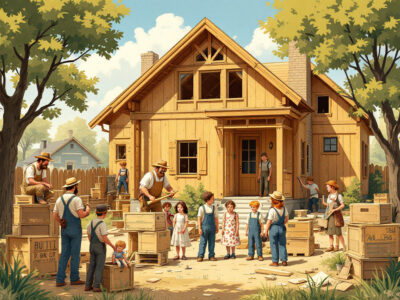
The Fascinating Legacy of Sears Catalog ‘Kit Homes’
A Revolution in Homeownership
In the early 20th century, Sears, Roebuck and Company transformed the way Americans built and bought homes. Through its Sears Modern Homes catalog, the retail giant offered high-quality, mail-order house kits that allowed everyday people to construct their own homes—sometimes with the help of family and friends, much like traditional barn-raisings. Between 1908 and 1940, Sears sold more than 70,000 of these homes across North America, offering over 370 different architectural designs to fit a wide range of budgets and styles.
From Coast to Coast: Where You Can Find Sears Homes
Although Sears homes were most commonly sold in the Midwest and along the East Coast, their reach extended far beyond. Homes have been discovered as far south as Florida, as far west as California, and even in Alaska. A few examples have also been found in Canada, showing the widespread appeal of these innovative kit homes.
Cutting-Edge Features for the Time
Sears Modern Homes weren’t just affordable—they also featured the latest in home construction technology. Many models included central heating, indoor plumbing, and electricity, which were still considered luxuries in the early 1900s. However, not all designs came standard with these features, and homeowners could choose from various customization options.
The home kits were typically shipped by railroad in boxcars, arriving with nearly everything needed for assembly, from lumber and shingles to nails and paint. Some homeowners took on the challenge of building their new homes themselves, while others hired local carpenters or contractors to handle construction. Sears even offered professional assembly services for those who wanted expert craftsmanship.
The End of an Era—and the Challenge of Identifying Sears Homes Today
By 1940, Sears discontinued its Modern Homes catalog, bringing an end to this unique chapter in American housing history. Unfortunately, a few years later, all sales records were destroyed in a corporate house cleaning. As a result, identifying Sears homes today requires thorough research, since many competitors—including Aladdin, Bennett, Gordon-Van Tine, Harris Brothers, Lewis, Pacific Ready Cut Homes, Sterling, and Montgomery Ward (Wardway) Homes—offered similar designs.
For history buffs and architectural enthusiasts, uncovering these hidden gems remains a rewarding challenge. Whether you live in a historic neighborhood or are simply fascinated by early 20th-century homebuilding, Sears kit homes serve as a reminder of a time when owning a house became more accessible than ever before.








































